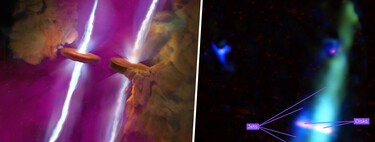The James Webb Space Telescope has surprised astronomers with a weather forecast for a not-so-distant exoplanet: WASP-43b.
A Jupiter stuck to its star. Located at 283 light years from EarthWASP-43b is what is known as a “hot Jupiter,” a planet similar in size to Jupiter that orbits its star at a much smaller distance.
WASP-43b is located 2.1 million kilometres from the star WASP-43. A distance so surprisingly short that it completes an orbit in just 19 Earth hours, which causes wind gusts of 9,000 kilometres per hour. But that is not its main problem.
An extreme climate. The close embrace between WASP-43b and its star has caused the planet to become tidally locked, meaning one of its sides always points toward the star.
The side facing the star is baking at a scorching 1,250 degrees Celsius. capable of melting aluminumThe side facing away from the star experiences an eternal night at a temperature that is not much more pleasant: 600 ºC.
Why is it so hot at night? Because of the hyper-hurricane winds we mentioned earlier, which transport vaporized material, such as molten rock, from the day side to the night side. The material cools and condenses into liquid droplets, forming clouds of molten rock that can be observed through the Webb telescope.
The space telescope has also allowed the atmospheric composition of the planet to be characterised, and has not only confirmed the presence of water vapour on both, but also the absence of methane. Winds prevent the formation of this gas, which is very common on hot Jupiters.
Strange planets. The Webb team used its Mid-Infrared Imager (MIRI) to observe light variations on either side of the inhospitable planet, then followed up with the Webb team’s Near-Infrared Spectrometer (NIRSpec).
The findings demonstrate once again how truly strange planets outside our solar system can be. Webb has also found planets covered in boiling water – planets as light as cotton candy.
Image | ESO
At Xataka | We have discovered a water cycle never seen before in the universe. All thanks to the James Webb Space Telescope







![[Img #74130]](https://thelatestnews.world/wp-content/uploads/2024/10/Richard-Dawkins-The-scientist-who-changed-our-understanding-of-evolution-150x150.jpg)



![[Img #74130]](https://thelatestnews.world/wp-content/uploads/2024/10/Richard-Dawkins-The-scientist-who-changed-our-understanding-of-evolution-300x200.jpg)

Add Comment